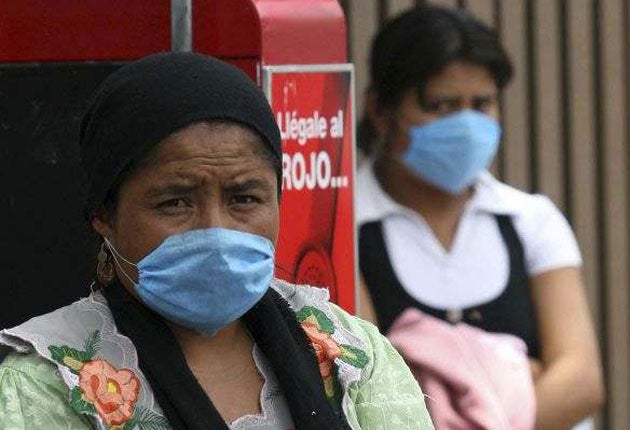The first person to die of swine flu was a 39-year-old tax inspector whose job required her to make door-to-door visits, putting her in contact with at least 300 unsuspecting members of the public when the disease was at its most virulent, Mexican authorities have said.
Maria Adela Gutierrez, a census-taker in the southern tourist city of Oaxaca, was admitted to a local hospital on 8 April and died five days later. She'd been suffering acute respiratory problems, exacerbated by diabetes and severe diarrhoea, and is believed to have infected scores of people.
The story of her death, which occurred three weeks before the virus was officially identified, came as Mexico remained on a state of high alert, with schools, government offices and many workplaces closed. The suspected death toll in Mexico reached 152 last night, with over 2,000 people infected. In the US the confirmed total of cases jumped to 64; California, with more than a dozen infected, declared a public health emergency and the World Health Organisation said it had notification of 79 confirmed cases worldwide.
Ms Gutierrez's demise may fuel controversy over Mexico's handling of the outbreak, which has been criticised as chaotic and secretive. Authorities at Oaxaca's Hospital Civil Aurelio Valdivieso, where she was treated, did not confirm that an infectious disease had broken out there until 21 April, by which time one further patient had also died.
Doctors initially thought Gutierrez was suffering from pneumonia. But when 16 further patients exhibited signs of severe respiratory infection, they established a quarantine area around the emergency room. Shortly afterwards, state health authorities began to track down every person she'd had recent contact with and conduct check-ups.
That discreet search suggested that Gutierrez may have unwittingly been a latter-day "Typhoid Mary". It turned up more than 300 people, including many members of the public whom she'd interviewed as she knocked on doors in late March and early April. Local sources told Veratect, the US disease-tracking company which sounded the alarm, that between 33 and 61 of those interviewees "exhibited symptoms" of a flu-like illness, though none have died.
Oaxaca is the historic capital of Oaxaca state, a mountainous region on Mexico's southern Pacific coast. Its location may be crucial to tracking the spread of swine flu, because it borders Veracruz, the state where the virus is believed to have first infected humans.
Edgar Hernandez, a boy who contracted the disease on 2 April and subsequently made a full recovery, was on Monday identified by Mexico's health secretary Jose Angel Cordova as "patient zero" – the first officially identified victim of the disease. He lives in the small town of La Gloria, in Veracruz province, five miles downwind of a vast pig farm identified a potential source of the outbreak. The farm is owned by owned by Smithfield Foods, a US agribusiness corporation, whose Mexican subsidiary raises a million pigs per year.
In February, dozens of locals began falling ill from a mysterious, flu-like disease. On 6 April, authorities in La Gloria declared an "alert," saying 400 people had required treatment and 1,800 were exhibiting respiratory problems. The town has a population of 3,000.
Public health workers sealed off the town and began exterminating huge numbers of flies that had reportedly begun swarming through homes. However, they are yet to identify this outbreak as swine flu. News teams who have descended on the town have been urged against jumping to conclusions.
But the locals aren't convinced. Jose Luis Martinez, a 34-year-old resident of La Gloria, told reporters yesterday that he knew the disease which had infected his town was swine flu the minute he heard description of its symptoms: fever, coughing, joint aches, severe headache and, in some cases, vomiting and diarrhoea. "When we saw it on the television, we said to ourselves, 'This is what we had,' " he said. "The symptoms they are suffering are the same that we had here."
Factory farming is already a contentious issue in Veracruz state because thousands of farmers claim they were evicted from their land there by the Mexican government in 1992, in an alleged move to make way for US farming companies seeking to exploit relaxed welfare standards. If La Gloria was indeed the source of the original outbreak, it is likely to have quickly spread to major cities. Roughly half the people with homes in the town live and work in Mexico City during the week.
Yesterday, the capital was again in a state of high alert. Most people were wearing surgical masks in public, large gatherings of people are banned, restaurants can only serve take-out food, and bars forced to shut at 6pm. Those measures are almost certainly too late. Swine flu is likely to have arrived in the city during the first fortnight of April – timing which may have been fatal, since it coincided with Semana Santa (Holy Week), bringing a million people to the capital from all over the country.
'Typhoid Mary'
Mary Mallon was an Irish chef who became the first person in the US to be identified as a carrier of typhoid fever. She is believed to have infected 53 people, three of whom died. She denied spreading the disease and refused to cease working. Born in 1869, she died in quarantine in 1938.

Join our commenting forum
Join thought-provoking conversations, follow other Independent readers and see their replies
Comments